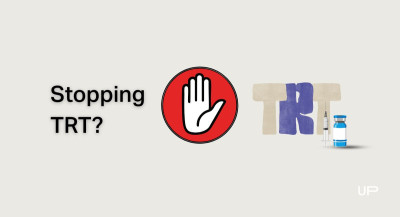Why You Must Discard Your TRT Vial On Time: Safety Rules For Testosterone & HCG Injections


For many men undergoing testosterone replacement therapy (TRT) in Canada, multi-dose vials are a convenient way to manage regular injections at home.

These vials contain several doses of testosterone or related medications, designed to be punctured multiple times over a set period. However, some patients mistakenly believe that as long as there’s liquid left inside, it’s safe to keep using the vial.
In reality, every puncture increases the risk of contamination — and stretching the vial beyond its safe use period can compromise sterility and put your health at risk.
Topics covered in this article:
Sterility Risk and Why Expiration (Beyond-Use) Matters
When it comes to injectable medications used in testosterone replacement therapy (TRT), sterility directly affects safety. Each time you puncture a multi-dose vial, a small chance of contamination is introduced. Over weeks of use, this risk increases, which is why understanding sterility and expiration guidelines is so important.

What Sterility Means
Let’s start with the basics.
Sterility means a medication is completely free from bacteria, fungi, or viruses. Injections bypass the body’s normal defences — the skin, lungs, and digestive system — and deliver medication straight into tissue or the bloodstream. That’s why keeping injectable solutions sterile is non-negotiable.
- Contamination doesn’t always make the vial look “bad” or cloudy — invisible microbes can still grow.
- According to Public Health Ontario and the CDC, most contamination happens when a vial is punctured multiple times in non-sterile environments.
- Once sterility is compromised, even a small infection can become serious.
How Multi-Dose Vials Stay Protected
Manufacturers design multi-dose vials with safeguards to help maintain sterility after opening, but these protections only work for a limited time.
- Preservatives slow bacterial growth after the first puncture.
- Sterile manufacturing ensures vials start germ-free.
- Proper storage — following temperature and light instructions — preserves those protections.
- Good injection hygiene matters: always clean the rubber stopper with alcohol, use a new sterile needle, and never leave a needle in the vial.
These practices delay contamination but don’t stop it forever.
Why the “28-Day Rule” Exists
You may have heard of the 28-day limit; it’s not arbitrary.
Pharmacies and regulators use challenge testing, where vials are purposely contaminated to see how long preservatives can keep them sterile. The results show that beyond roughly 28 days, even preserved vials may allow microbial growth.
- Public Health Ontario and the CDC recommend discarding opened vials within 28 days, or sooner if sterility is uncertain.
- Some products have longer or shorter validated timelines, depending on the formula and preservative used.
- “Beyond-use date” refers to the safe window after first puncture, not the printed expiry date on the label.
What Real-World Studies Show
Research confirms that contamination happens even with proper handling.
- Studies published by the National Library of Medicine (PMC) found contamination in about 5 % of multi-dose vials tested in healthcare environments.
- The most common organisms were Staphylococcus aureus and Bacillus species.
- The more often a vial is punctured, the higher the risk becomes.
While 5 % might sound small, for anyone injecting regularly, each additional use increases exposure risk. Following discard timelines is the simplest way to stay safe.
TRT Products and Their Safe Use Periods
Each injectable TRT product (testosterone formulations or HCG) is formulated a bit differently. That means the time you can safely use a multi-dose vial after the first puncture varies. In this section, we’ll show the discard times for the specific products you asked about and explain why those timelines differ.

Safe Use Periods for Specific TRT & HCG Vials
Below are the discard periods you specified. Be aware: in many cases, standard references default to 28 days unless a manufacturer’s data allows longer use.
- Testosterone Cypionate — discard 56 days after first puncture
- Testosterone Enanthate — discard 28 days after first puncture
- HCG (Human Chorionic Gonadotropin) — keep refrigerated after reconstitution (mixing with the provided liquid) and discard 28 days after the first puncture.
These are your internally defined safe windows. It’s important that each product’s label, formulation, preservative, and internal validation support those timelines.
Why Different Products Have Different Windows
The various discard times depend on several key factors. Here’s what causes one drug to last longer than another before sterility can no longer be assured:
- Formulation differences: Some formulations are more stable. For example, oil-based testosterone esters (like cypionate) may provide a more stable environment for preservatives to work for a longer period, compared to aqueous or reconstituted solutions.
- Preservative efficacy and concentration: The type and amount of antimicrobial preservative used (e.g. benzyl alcohol, benzyl benzoate, etc.) affect how long microbial growth can be suppressed. Stronger or more stable preservatives enable a longer safe window.
- Stability under storage conditions: Temperature, light exposure, and how often the vial is opened influence how well the preservative and drug remain effective over time.
- Manufacturer validation/challenge testing: The only way a manufacturer can approve a vial for longer than the “default” period is by conducting challenge testing (deliberately introducing microbes and showing they don’t proliferate over time). Unless that testing supports a longer timeline, regulatory guidance defaults to ~28 days. (For example, most multi-dose vials are conservatively labelled for 28 days unless otherwise validated.)
- Regulatory & pharmacopeial standards: The United States Pharmacopeia (USP) general guidelines, and broadly adopted standards, set a default beyond-use date of 28 days for multi-dose vials unless otherwise specified. Many institutional policies require adherence to 28 days unless explicit data support longer.
What Happens If You Use After the Safe Window
Ignoring the discard timeline of a multi-dose vial isn’t just a technical rule. It can have real, dangerous consequences. When a vial is used past its safe period, the risk of contamination and infection rises. In this section, we’ll walk through what can go wrong, what “sterility loss” vs “efficacy loss” means, and why “I used it and didn’t get sick” isn’t reliable logic.
Increased Risk of Bacterial or Fungal Contamination
Once the vial’s safe use window is exceeded, microorganisms have had more time and opportunity to enter and multiply.
- Even if the vial appears clean, invisible bacteria or fungi may be present. Over time, they can grow to dangerous levels.
- Studies assessing multi-dose vials show measurable rates of bacterial contamination after opening. (For example, one recent study of opened parenteral vials found bacterial growth in some samples.)
- Injections that bypass skin and tissue barriers allow microbes direct access to deeper tissues or the bloodstream. The more contaminated the fluid, the higher the risk.
Possible Local Infections, Abscesses, or Bloodstream Infection
Contaminated injections can cause infections at the injection site or, worse, systemic infections.
- Local infections, like redness, swelling, pain, and warmth, may indicate bacterial invasion into tissue. If not treated, these can progress to abscess formation (a pocket of pus).
- If bacteria enter the circulation, bacteremia or fungemia (fungi in the blood) can occur, which may lead to sepsis in severe cases.
- In healthcare settings, contaminated injectable products have been linked to documented bloodstream infections and serious outbreaks.
- In the worst-case scenario, infections can spread to organs, require hospitalization, or even become life-threatening.
Loss of Sterility vs. Loss of Efficacy
It’s important to distinguish two things:
- Loss of sterility means microbes are present; the solution is no longer safe to inject.
- Loss of efficacy means the drug has degraded or lost potency.
Using a vial beyond its validated window generally affects sterility first, not efficacy. A vial may still deliver some active drug, but that doesn’t mean it's safe. The presence of contaminants makes it unacceptable, regardless of potency.
Why “I Used It Past That Time and Didn’t Get Sick” Is Risky Logic
It’s tempting to think, “I stretched the vial before and nothing bad happened, so it’s safe.” But that reasoning is flawed.
- Absence of illness once doesn’t guarantee safety in future uses. Contamination may be low-grade, or an immune response may prevent symptoms initially.
- Infections might be mild or subclinical (you didn’t notice), or symptoms may show later.
- Risk increases cumulatively: each additional injection after the safe period raises the chance of contamination.
- Medical guidelines and pharmacopeial rules exist because they are based on safety margins and statistical risk, not anecdotal experience.
Best Practices to Minimize Contamination Risk
To protect yourself while using multi-dose vials for TRT, you need more than just correct discard dates. Good habits and strict hygiene reduce contamination chances dramatically. Below are proven steps you and your provider should always follow.
- Storage Guidelines for TRT Medications: Proper storage helps preserve sterility and medication strength. Testosterone Cypionate and Testosterone Enanthate: Keep at room temperature, away from direct heat and light. Do not refrigerate unless told otherwise by your pharmacist. HCG (Human Chorionic Gonadotropin): Store the powder at room temperature, away from heat and light. After reconstitution (mixing with the provided liquid), keep the vial refrigerated and discard it after 28 days.
- Label the vial with the date of first puncture: Right after you puncture a vial for the first time, write the date clearly. This lets you and anyone assisting you know exactly when the safe period ends.
- Use aseptic technique every time: Always clean your hands thoroughly. Before every use, disinfect the rubber stopper with an alcohol swab and let it dry. Use a fresh sterile needle and syringe each time you draw medication.
- Never leave a needle in the vial between uses: Even momentary insertion creates a direct pathway for bacteria to enter. The CDC explicitly states that keeping a needle inserted in a multi-dose vial is a major contamination risk.
- Handle vials in a clean environment: Always prepare injections on a clean, dry surface away from sinks or bathrooms. Keep your workspace organized and disinfected before each use to reduce contamination risk.
- Discard if anything seems off: If you observe cloudiness, discoloration, floating particles, or any odour, throw the vial away immediately. Even if it looks fine, never hesitate to discard if sterility is ever in doubt.
These habits add layers of protection between the vial and your body. They don’t replace following the discard timeline, but they help you stay safe during the time the vial is in use.

Patient Action Plan and Reminders
Staying consistent with safety rules is easier when you plan ahead. Having a simple routine helps you avoid mistakes, reduce waste, and stay confident that every injection is safe. Here are practical steps to help you manage your TRT vials responsibly.
When the Discard Date Arrives
When your marked discard date comes, it is time to stop using that vial, even if some medication is left.
- Do not try to stretch it or “finish what is left.”
- Discard the vial in a sharps container or follow your local pharmacy’s disposal instructions.
- Start using a new vial that has not been opened or punctured.
Plan Your Injections to Reduce Waste
Good scheduling prevents you from running out of medication too early or keeping leftovers too long.
- Keep a simple calendar or reminder app for injection days and vial expiration.
- Estimate how many doses each vial provides within its safe use period.
- Coordinate refills with your pharmacy so you have a new vial ready before the current one expires.
Practical Tips for Smarter Use
A few small adjustments can make your routine safer and more efficient.
- Ask your provider whether smaller-volume vials are available to reduce leftover medication.
- Keep extra sterile syringes and alcohol swabs on hand so you never reuse materials.
- Store vials away from sunlight and at the temperature indicated on the label.
When to Contact Your Clinician or Pharmacist
If anything about your medication seems unclear, or if you notice unusual reactions at the injection site, contact your healthcare provider right away.
- Your clinician can confirm whether your vial is still safe to use.
- Your pharmacist can review storage instructions or clarify beyond-use timelines for your specific brand.
- Never rely on online advice or assumptions about product safety.
Maintaining a consistent safety routine protects your health and ensures your TRT treatment works as intended. Careful planning, correct storage, and timely disposal all contribute to a safe and effective therapy experience.

Conclusion
For patients using testosterone replacement therapy (TRT) in Canada, following proper vial safety rules is essential. Multi-dose vials remain safe only for a limited time after first use.
- Testosterone Cypionate should be discarded 56 days after the first puncture.
- Testosterone Enanthate should be discarded 28 days after the first puncture.
- HCG (Human Chorionic Gonadotropin) should be kept refrigerated after reconstitution and discarded 28 days after the first puncture.
By marking your vials, storing them correctly, and discarding them on time, you reduce the risk of contamination and infection while keeping your TRT treatment safe, consistent, and effective.
References
UPGUYS has strict sourcing guidelines to ensure our content is accurate and current. We rely on peer-reviewed studies, academic research institutions, and medical associations. We strive to use primary sources and refrain from using tertiary references.- Updated Guidance on the Use of Multidose Vials, Public Health Ontario,
https://www.publichealthontario.ca/en/Health-Topics/Infection-Prevention-Control/Clinical-Office-Practice/Multidose-Vials - Preventing Unsafe Injection Practices, CDC,
https://www.cdc.gov/injection-safety/hcp/clinical-safety/index.html - Evaluation of the sterility of single-dose medications used in a multiple-dose fashion, PubMed,
https://pubmed.ncbi.nlm.nih.gov/29089656/ - MULTI-DOSE MEDICATION VIALS - USE, HANDLING, AND EXPIRATION, Texas Tech. Physicians,
https://ttuhscep.edu/opp/_documents/EP-4/ep-4-09.pdf?utm_source - Bacterial contamination of single and multiple-dose parenteral injection vials after opening and antibiotic susceptibility of isolates at Jimma Medical Center, Jimma, Southwest Ethiopia, Science Direct,
https://www.sciencedirect.com/science/article/pii/S2590088923000239 - CDC Grand Rounds: Preventing Unsafe Injection Practices in the U.S. Health-Care System, CDC,
https://www.cdc.gov/mmwr/preview/mmwrhtml/mm6221a3.htm?utm_source
This article is written for informational purposes only and does not constitute medical advice. The information provided in the articles cannot and should not replace advice from a healthcare professional. Talk to your healthcare provider about any physical or mental health concerns or the risks and benefits of any treatment or medication.





